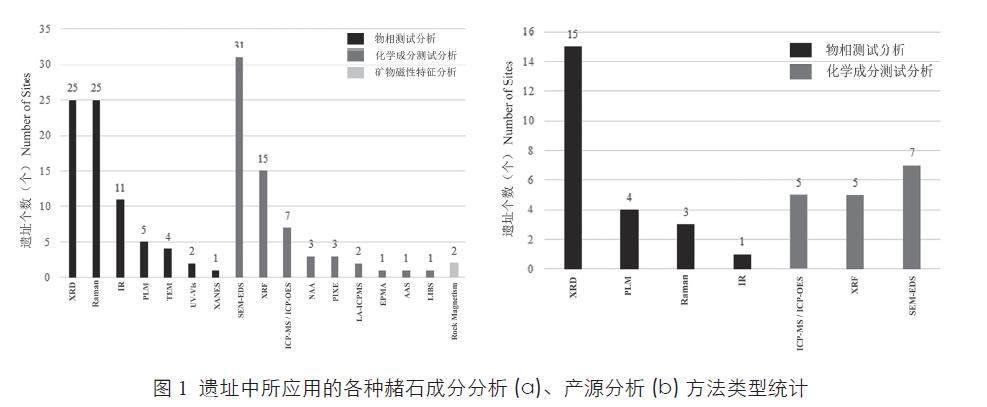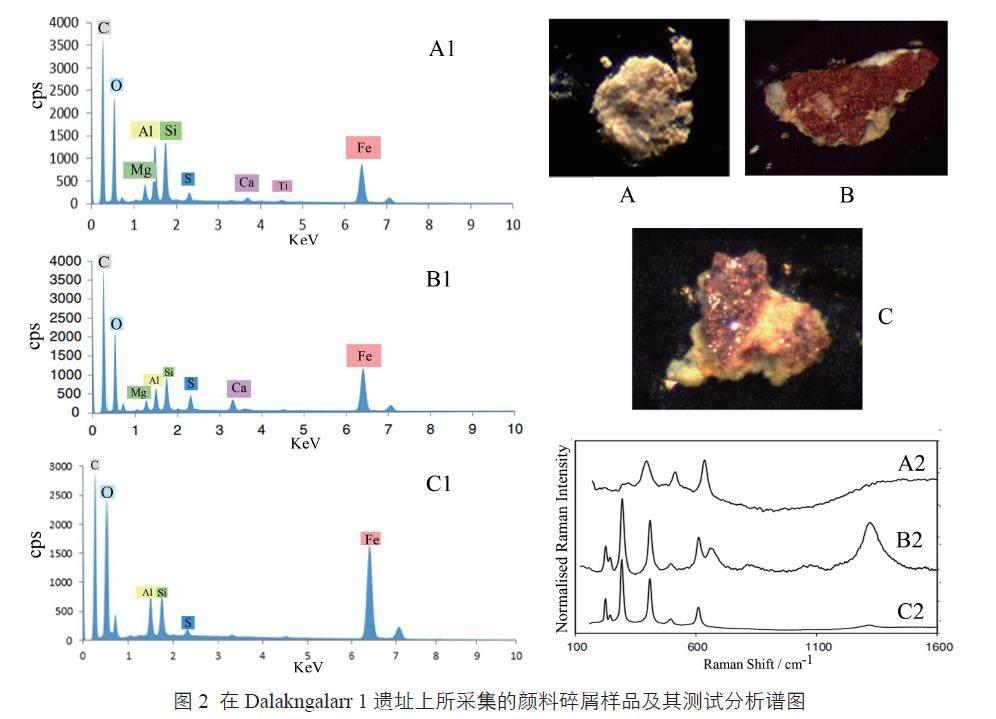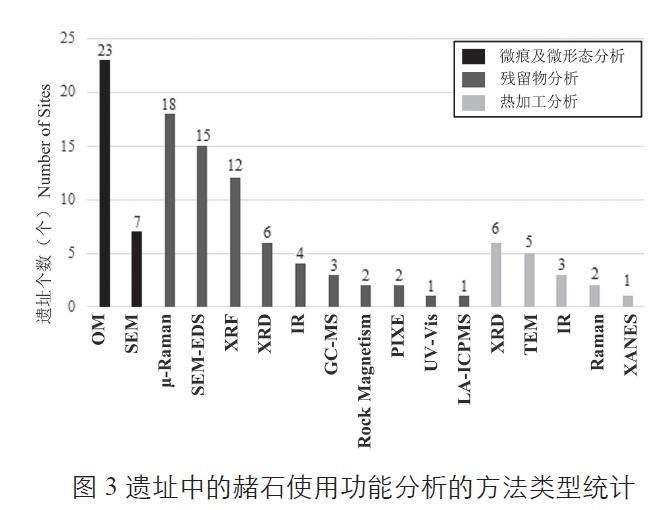旧石器时代考古中出土的赭石及相关遗物的研究方法
2024-06-30许竞文浣发祥杨石霞
许竞文 浣发祥 杨石霞



摘要:赭石是考古发现中一类较为常见的矿物颜料。遗址中的矿物颜料研究对于解读中更新世以来人类行为的演化与发展以及人群的迁徙和交流互动具有重要意义。目前,我国出土和被识别的赭石相关考古发现日益增多,但研究程度还有待深入,旧石器时代考古发现中相关材料的识别和解读较为有限。如何综合利用多学科测试分析方法建立起完善的研究方案,深度挖掘赭石颜料利用所指示的人类行为发展模式和民族学意义,还需要我们进行系统性地总结和思考。因此,本文通过梳理现有的考古学、地球物理、地球化学和民族学等各领域的国内外研究成果,归纳了旧石器时代考古遗址中出土的赭石及相关遗物的主要研究内容——成分定性、产地溯源和加工技术分析,以及各自适用的分析方法。综合多项研究案例,我们认为在性质、产地和技术分析的基础上,需要结合民族学方法、生态环境背景才能更有效地解读和复原史前人类的行为模式及社会学、民族学意义。
关键词:旧石器时代;赭石;理化分析;人类学
1 引言
随着考古发掘技术和科技测试手段的不断提高,国内外旧石器时代遗址中除石器和骨器以外的诸多文化遗物也逐渐被发现,并得到深入研究,如颜料、药物、特殊饰品等。这些具有特殊内涵的文化遗存进一步揭示了史前人类对自然资源的认知程度与开发能力,以及意识形态发展水平,对于深入认识漫长且复杂的人类行为演化历程具有重要意义[1]。作为最易获取的天然矿物颜料之一,赭石是较早被识别和确认的与人类意识形态活动相关的物质文化遗存,为史前艺术提供了鲜明的红色系颜料。
赭石是一种天然的地质矿物,富含铁的氧化物或氢氧化物,如针铁矿FeO(OH)、赤铁矿Fe2O3 和磁铁矿Fe3O4 等[2]。赭石中含铁组分的类别、含量及其晶体形态的变化决定了其条痕的色相、饱和度和明度[3]。故而采集不同类型的赭石能够生产出或暗或明的黄色至红棕色粉末,以满足史前人类对红色系“颜料”的需求。
史前人类利用赭石的历史可以追溯到距今30~50 万年前[4,5],随后在全球各地发现了古人类更加丰富和多样化的赭石利用行为[6-9]。史前遗址中赭石的出土形式通常包括:1) 保留了加工痕迹的碎块或粉末,如加工成蜡笔状的赭石、残留在石磨盘上的红色痕迹等[10-13];2)象征行为的直接证据,如岩画、个人装饰品上的涂色、埋葬中的赭石粉末等[14-22];3) 功能性利用的间接证据,如附着在石器末端的赭石碎屑残留、赭石碎屑与牛奶的混合物,以及残留在鹿牙装饰品上的赭石、木炭和动物油脂混合物[23-26]。保存良好的赭石染色遗物遗迹相对稀少,全球各地分布零星,难以追踪赭石使用模式的历时性。尽管如此,记录赭石加工技术的演变对于全面了解旧石器时代的赭石开发策略和族群文化面貌是至关重要的。
在通过土壤微形态分析等辅助手段排除原生埋藏地层受沉积期后改变的前提下,本文将总结如何综合利用不同的测试方案,准确评估遗址中是否存在赭石颜料的利用及其利用方式和程度,并说明在文化习俗、宗教信仰、审美与社会等级制度等人类学研究方面,赭石的考古学研究所扮演的重要角色。
2 赭石的考古学分析方法及案例
认识赭石的理化性质、分析赭石的开发策略,是目前旧石器时代遗址考古中赭石研究的主要研究方向。目前应用于考古出土中赭石及相关遗物的具体分析方法包含表观显微分析和理化性质分析这两个层次。表观显微分析是指利用显微镜观测赭石表面的微痕,如坑疤、线性痕等。理化性质分析则是指对赭石进行物相或化学成分组成的测试分析以达到鉴定赭石所包含的矿物成分的目的。显微镜观测、光谱学分析和岩石磁学等测试手段在研究实践中可以实现以上两个层次的分析,并有效地获取赭石的矿物成分、产源及人类对其加工利用程度等信息。获取考古遗址出土赭石的具体信息,有助于我们最终认识其所反映的当时人群流动性、资源获取能力和象征行为等。
2.1 矿物成分分析
通过分析疑似样品的物理化学性质,即矿物的元素百分比组合、晶体或分子结构和磁性特征,我们可以检测出样品的矿物成分[27,28],进而判断样品是否为赭石。笔者统计了已发表的54 例旧石器时代遗址中出土赭石及其相关遗物的研究方法[5,10-71],数据统计结果表明,分析矿物元素组合的常用测试手段包括X 射线荧光光谱分析(X-ray fluorescence,XRF) 和电感耦合等离子体质谱(Inductively coupled plasma mass spectrometry, ICP-MS)等;用于分析矿物晶形或分子结构的常用测试手段则包括X 射线衍射(X-ray diffraction,XRD)、拉曼光谱分析(Raman)、红外光谱分析(Infrared spectrometer, IR)、X 射线吸收近边结构分析(X-ray absorption near edge structure, XANES) 和偏光显微镜观察(Polarizedlight microscopy, PLM) 等(图1: a)。另外,赭石的本质即含铁矿物,其磁性特征由磁铁矿、赤铁矿、磁赤铁矿的含量和粒度决定[72-74]。王法岗等人通过岩石磁学将下马碑遗址中的样品定性为赭石,这是中国近期在考古出土赭石的研究中应用岩石磁学的一项成功案例[13]。
除了上述所提到的测试手段之外,扫描电镜耦合能谱分析技术(SEM-EDS) 也是一种常用的理化分析手段(图1: a)。扫描电镜能谱分析技术具有很强的综合性分析能力,可以耦合X 射线能谱仪、阴极荧光光谱分析等对赭石样品的元素组成和晶体结构进行分析[75,76]。例如,澳大利亚北部的达拉肯加拉尔1 号(Dalakngalarr 1) 遗址[63] 发现了岩画遗迹,在岩画上采集少量的黄色、红色和紫色碎屑样品并用于扫描电镜观测,耦合能量色散X 射线光谱(EDS) 及拉曼光谱(Raman) 分析,确认了这三种颜色的微碎屑均为赭石(图2)。
2.2 产地溯源分析
在确认研究样品为赭石后,对矿物元素组合的量化和特征晶形的示踪进行物源分析也是史前赭石的一个重点研究方向[77-80]。在溯源研究前,需要对遗址周边进行地质调查,对所有大量产出含铁矿物的地质区域进行定位,且采样工作应尽可能地覆盖整个露头延伸的范围[81,82]。本文统计了Fumane、Tagliente、Roc-de-Combe、Diepkloof、Tito Bustillo、MonteCastillo、Blombos、Hohle Fels、Vogelherd、Es-Skhul、Torajunga、El Mirón 等遗址[5,29,36-39,42,46,59,62]对赭石的产地溯源分析所采用的测试手段,其数据表明拉曼光谱、X 射线衍射分析、傅里叶红外光谱和偏光显微镜等实验能够测试矿物的特征晶形以示踪赭石样品的产地,而X射线荧光光谱分析、电感耦合等离子体质谱和扫描电镜能谱分析技术则是通过量化赭石中的矿物元素组合从而进行溯源分析(图1: b)。其中,偏光显微镜(PLM) 的原理是利用晶体光学的性质对矿物进行岩相鉴定与分析[83]。该方法虽然能够通过矿物的组构分析揭示其成矿原因,但是其溯源能力有限,目前仅有Cavallo 等人[62] 对Fumane 洞穴遗址和Tagliente 岩厦遗址利用此方法获得了较好的溯源成效。值得补充的是,偏光显微镜观测需要将岩石或矿物进行磨片处理,对考古样品来说有巨大的损耗,因此研究者需谨慎选择适用于该方法的赭石样品,并在实验前做好样品的记录工作。
Dayet 等人对位于南非开普的迪普克鲁夫岩厦(Diepkloof Rock Shelter)遗址开展了系统的赭石溯源研究[37]。他们在遗址旧石器时代中期Howiesons Poort 工业的堆积中发现了数千块赭石,通过X 射线衍射和微区拉曼测试并比对其黏土矿物的结构,准确识别出了较为可靠的远距离源区。对比研究进一步显示迪普克鲁夫遗址的赭石开发模式与周边其他同时期的遗址存在差异[41],具有一定的区域性特征,并可能与远距离的人群互动和文化交流相关[69, 86-89]。总之,通过赭石的溯源分析来指示人群的活动范围,能够判断是否存在远距离运输,并窥探史前人群的社会规模和结构[84,85]。
2.3 加工方式及其利用程度分析
史前人类对自然资源的认知水平不断提高,其表现形式包括开发出赭石的多样用途、通过提取不同颜料的色素进行其意识的表达与刻画等[7, 27,28, 68, 90-92],这些相关信息均可在对赭石的考古研究中获得,因此旧石器时代考古出土赭石的另一个重点研究方向即复原人类对赭石的加工方式及利用程度。笔者通过统计Klasies River Cave、Hohle Fels、周口店、鸽子山第十地点、下马碑、Altamira、Sibudu、Roc-de-Combe、Diepkloof、Porc-Epic、Blombos、Qafzeh、Bushman、Jerimalai、Fumane、Rose Cottage Cave、水洞沟第二地点等38个遗址应用于研究赭石使用与加工方式的测试手段[6,11-13,15,16,24-26,27-35,40,41,43,45,47-53,55-59, 63,66,68,70],将该研究方向的内容总结为微痕及微形态分析、残留物分析和热加工分析(图3)。此外,根据赭石在遗址中不同的出土形式,可通过表观显微分析和理化性质分析来分步骤确定其功能。
显微结构分析是在考古文物工艺研究中不可或缺的一种手段。显微镜观测在赭石研究中的应用分为三种情况:一是直接对赭石碎块进行表观微痕分析;二是对人工制品表面微区的残留物进行电镜扫描,观察其上是否具有赭石粉末的残留;三是对赭石碎块、人工制品或岩画上的赭石染色残留物进行透射电镜扫描,通过其物相来判断赭石是否由热加工生成。在第一种情况中,表观微痕分析(Usewear analysis) 是指利用显微镜观测赭石表面的磨损痕迹,再通过比对实验室的实验结果,推测史前人类对其的加工使用方式[93,94]。赭石碎块表面出现定向的平行擦痕意味着古人类曾通过在石磨盘等坚硬的器具上摩擦赭石以取得红色粉末[95];较深的切槽说明古人类利用石器或骨器等工具对赭石进行刮削取粉[70];在其表面观测到打击点及坑疤,则可以推测古人类为便于摩擦取粉,在使用前将其敲击成碎块[29]。而扫描电子显微镜(SEM) 和透射电子显微镜(TEM) 的分辨率极高,具有较大的放大倍数,足以用于检测人工制品上是否残存赭色微碎屑[59,60,75,82]。扫描电镜与透射电镜的不同点在于:扫描电镜只能得到样品表面形态的信息;而透射电镜依靠电子束成像,得到的是晶体中原子或原子团在特定方向上结构投影的信息,从而确定其晶体结构。透射电镜的这一特点尤其适合运用于考古出土中赭石的受热分析,即第三种情况。
对于埋葬中人工制品和岩画上的赭石粉末遗存来说,利用扫描电镜耦合能谱、拉曼光谱和气相质谱等理化分析手段,可以对考古样品进行残留物的成分分析,进而对其来源和应用情况进行推理(图3)[25,26,96]。周口店山顶洞史前穿孔饰品的再研究提供了一个可靠案例:通过扫描电镜能谱分析技术检测到三枚穿孔獾牙上的红色残留物均为赭石;同时,赭石染色的微区位置指示着穿孔獾牙可能曾被缝制于被赭石鞣制过的皮革衣物上[12](图4)。更为有趣的是,獾牙饰品1、2 与獾牙饰品3 上残余的赭石成分不同,加之穿孔加工技法不同,可能暗示了饰品是由不同个体或群体制作的。
此外,史前人类在旧石器时代晚期就已意识到加热赭石能使其产生不同颜色[97]。赭石在受热后,Fe-O 和O-O 键长会发生改变,其对称性八面体结构扭曲,从而导致颜色加深[98]。因此,对赭石样品的赤铁矿分子结构进行测试后,便能够得知其是否受过高温作用。能够进行该项测试的手段包括但不限于X 射线吸收近边结构分析、红外光谱分析、X射线衍射、热释光分析、透射电子显微镜、岩石磁学和拉曼光谱分析(图3)。但是,我们仍需结合其他辅助方法以排除地质所导致的受热因素,才能判定赤铁矿分子结构的扭曲是否源于古人类的热加工处理。在赭石研究中,对遗址进行土壤微形态分析,能够更直观地判断考古埋藏中的赭石及石器上的红色残留是否源于自然埋藏过程的影响,如铁质淋滤、原生磁性矿物的风化与搬运等。土壤微形态分析(Micromorphology Analysis) 对土壤进行显微形态观测和描述,通过显微镜鉴定土壤剖面的矿物组成、风化状况等层相特征,排除遗址内地层后期扰动构造对遗存所造成的影响。该种方法一般需要在剖面上连续采样,精准地评估微区环境演变对遗址形成的影响,分析考古遗存与古人类活动的关系[99,100]。
2.4 小结
综上所述,对赭石开发策略的研究主要从产地溯源和加工方式及其利用程度这两个角度出发,以地球物理化学测试手段和微观显微鉴定相结合的方法为主(图5)。在众多的地球物理化学测试手段中,XRF、ICP-MS 和Raman 等无损或微损分析测试手段得到了较为广泛的使用。它们的优势在于功能多样化,不仅可以用于赭石的产地溯源,还能有效地揭示古人类对赭石资源的开发利用程度。而微观显微鉴定是考古学研究中的重要常规方法之一,该方法结合实验能够很好地推断赭石表面微痕的产生原因。
近年来,愈来愈多的学者尝试拓宽地球物理、地球化学与考古学的交叉研究和应用。例如,下马碑遗址的研究将岩石磁学的测试手段引入赭石的考古学定性分析中[13],朱弗里洞穴(Jufri Cave) 遗址研究中应用XANES 分析法判断赭石是否受到过热加工作用等[30]。只有综合利用不同的测试方法建立起适合的综合研究方案,明确考古发现中赭石的原料经济及其开发利用程度,才能最大程度地接近并复原史前人类的行为模式和社会文化。
3 赭石研究的人类学思考
史前人类对自然资源的认知发展最终催生出不同色彩的使用和装饰品的制作等一系列超出基本生存需求的意识行为[101]。颜料与装饰品等物质文化作为史前艺术的表现形式,隐含着人类对自我、他者关系的认知程度,承载着人类的精神文化和自我认知[102]。此外,作为身份和族群的标志,色彩和装饰品既体现了不同族群的艺术创作和文化发展的水平,亦可能隐含各族群之间的关系 [103,104]。赭石是获取“色彩”的重要物质资料,对赭石的研究是了解人类行为模式及族群文化的重要介质之一,其研究方法既借助了自然科学的理化分析,又紧密联系社会科学中民族学、文化人类学等其他领域的解析理论。在前文中已经对各类自然科学分析方法及其应用情况进行了深入的解析,而此处我们将尝试阐述如何建立起自然科学方法与社会学理论之间的关联。
3.1 理化分析与行为重建
自然科学为考古发现中的无机颜料研究提供了丰富的定性及定量的理化分析手段[67,105],帮助研究者重建古人类的颜料使用行为模式。在此基础上,学者可以广泛地关注古代颜料,如赭石、朱砂、炭黑、青金石和孔雀石等,尝试通过史前和古代艺术创作材料在时空上的变化去探究不同地理环境和历史条件下各族群的意识形态[106]。例如,在西班牙阿达尔洞穴遗址(Cueva de Ardales),Afica Pitarch Martí 等人[11] 通过X 射线衍射测试发现洞壁上出现两层不同源区的染色图层,利用铀系测年(U-Th) 得知其染色时间相隔两万年。这一行为被解释成古人类对“祖先”地盘的标记,意味着早在4 万年前古人类就已经在思考自我关系等哲学问题。
此外,地球物理化学常被用于古气候环境的重建[107,108],可以有效地帮助恢复考古遗址区域内的古环境。栖息地的气候环境、生态背景与人口规模和社会形态息息相关,是解释人类行为模式的重要部分。环境背景直接影响区域内自然岩矿资源的可获得性,以及人类获取资源、交换资源的路径[109]。在具体的研究中,地球物理、化学方法与考古研究相结合,有助于将生态适应、生产技术和人群扩散等因素串联起来,为探讨不同时空下人群和文化间的相互交流模式、活动空间变化提供更加全面且合理的解析[92,102,110],进而,这些综合研究能够更为恰当地解释环境因素在人类行为演化进程中所扮演的角色。
3.2 民族学与社会文化的阐释
旧石器时代遗址中赭石的利用是人类象征行为的考古学证据,亦被解释为人类演化史中行为现代性的关键要素[91]。利用现代民族学材料的相关记录是揭示赭石的史前用途及其加工过程的有效方法[111,112]。Rosso[70] 在研究埃塞俄比亚Proc-Epic 洞穴遗址中赭石粉末的粒度分析时,分别采集辛巴(Ova Himba) 部落和哈莫尔(Hamer) 部落用于涂抹头发及身体和服饰的赭石粉末样品,并开展了微痕实验和量化分析,最终通过借鉴现代民族学研究直接重建了4 万年前的赭石加工操作链。由于该遗址的地层序列跨时长达4500 年,出土赭石的标本量多至四千件,通过对不同类型的赭石及其处理方式的空间量化分析,有效地验证了东非地区赭石的加工模式具有连续且渐进的变化。
不拘泥于某个遗址中赭石的具体用途,而是更多地关注赭石所指示的行为和文化内涵—— 在时空维度的变化和在人类生产生活各层面的应用,是进行赭石研究的最终目的。在考古学背景下,颜料和其他象征物都承载着人类的风俗习尚、生业方式与社会结构等文化演变与发展规律的重要信息[104]。解读象征行为在人类族群分化与互动中的意义,离不开多学科相结合的方法及自然科学与社会科学的融通。
4 结语
近几年理化分析技术测试手段不断被应用于考古学科,扩宽了赭石等物质遗存研究的内涵,提高了考古研究工作的定性和定量化水平。除了对单个遗址的报道,关于赭石使用这一现象的综合性汇总及系统性分析也显得尤为关键。分析不同区域多个遗址内赭石历时性使用情况的异同,为我们探讨生态环境与生计模式、人口规模等文化元素互动的结果带来了不同的视角。综上所述,赭石考古的内容并不仅限于分析矿物成分、产地溯源及具体用途,其蕴含的行为信息对于阐释史前人类的交流迁徙与文化发展规律等内容有重要意义。目前而言,中国境内旧石器时代赭石利用的证据较为有限,有待未来开展更多更深入、更系统的识别与研究,以全面解读东亚地区赭石颜料开发策略的历时性发展和区域性特征。
致谢:感谢日本东北大学林乃如、中国科学院地质与地球物理研究所沈中山博士、中国科学院古脊椎动物与古人类研究所岳健平博士、中国科学院古脊椎动物与古人类研究所侯亚梅研究员在文章写作过程中进行的讨论和提出的宝贵建议。
参考文献
[1] Foley RA, Martin L, Lahr MM, et al. Major transitions in human evolution[J]. Philosophical Transactions of the Royal Society B,2016, 371: 20150229
[2] Cornell RM, Schwertmann U. The iron oxides: structure, properties, reactions, occurrences and uses[M]. Wiley-VCH. 2003
[3] Nicola M, Mastrippolito C, Masic A. Iron Oxide-Based pigment and their use in history[A]. In Faivre D. Iron oxide: from nature to applications[C]. New Jersey: Wiley Press. 2016: 544-566
[4] Watts I, Chazan M, Wilkins J. Early evidence for brilliant ritualized display: specularite use in the Northern Cape (South Africa)between similar to 500 and similar to 300 Ka[J]. Current Anthropology, 2016, 57(3): 287-310
[5] Brooks AS, Yellen JE, Potts Richard, et al. Long-distance stone transport and pigment use in the earliest Middle Stone Age[J].Science, 2018, 360(6384): 90-94
[6] 杨石霞,许竞文,浣发祥.古人类对赭石的利用行为在其演化中的意义[J]. 人类学学报,2022, 41(4): 649-658
[7] Barham LS. Systematic pigment use in the Middle Pleistocene of South-Central Africa[J]. Current Anthropology, 2002, 43(1): 181-190
[8] 周玉端,翟天民,李桓.旧石器时代人类对赭石的利用[J]. 江汉考古,2017(2): 43-51
[9] 申艳茹.中国旧石器时代遗址中赭石的功能[J]. 南方文物,2020(1): 187-192
[10] DErrico F, Moreno RC, Rifkin RF. Technological, elemental and colorimetric analysis of an engraved ochre fragment from the Middle Stone Age levels of Klasies River Cave 1, South Africa[J]. Journal of Archaeological Science, 2012, 39(4): 942-952
[11] Velliky EC, Porr M, Conard NJ. Ochre and pigment use at Hohle Fels cave: results of the first systematic review of ochre and ochre-related artefacts from the Upper Palaeolithic in Germany[J]. PLoS One, 2018, 13(12): e0209874
[12] D'Errico F, Pitarch Martí A, Wei Y. Zhoukoudian Upper Cave personal ornaments and ochre: rediscovery and reevaluation[J].Journal of human evolution, 2021, 161: 103088
[13] Wang FG, Yang SX, Ge JY, et al. Innovative ochre processing and tool use in China 40,000 years ago[J]. Nature, 2022, 603(7900): 284-289
[14] Marean CW, Bar-Matthews M, Bernatchez J, et al. Early human use of marine resources and pigment in South Africa during the Middle Pleistocene[J]. Nature, 2007, 449(7164): 905-908
[15] Cuenca-Solana D, Gutiérrez-Zugasti I, Ruiz-Redondo A, et al. Painting Altamira Cave? Shell tools for ochre-processing in the Upper Palaeolithic in northern Iberia[J]. Journal of Archaeological Science, 2016, 74: 135-151
[16] Pitarch Martí A, Zilh?o J, dErrico F, et al. The symbolic role of the underground world among Middle Paleolithic Neanderthals[J].Proceedings of the National Academy of Sciences, 2021, 118: 33
[17] Bar-Yosef Mayer DE, Vandermeersch B, Bar-Yosef O. Shells and ochre in Middle Paleolithic Qafzeh Cave, Israel: indications for modern behavior[J]. Journal of Human Evolution, 2009, 56(3): 307-314
[18] Song YH, Cohen DJ, Shi JM. Diachronic change in the utilization of Ostrich Eggshell at the Late Paleolithic Shizitan Site, North China[J]. Frontiers in Earth Science, 2022
[19] Aldhouse-Green S, Pettitt P. Paviland Cave: contextualizing the ‘Red Lady[J]. Antiquity, 1998, 72(278): 756-772
[20] Trinkets E, Buzhilova AP. The death and burial of sunghir 1[J]. International Journal of Osteoarchaeology, 2010, 22(6): 655-666
[21] Vanhaeren M, dErrico F, Stringer C, et al. Middle Paleolithic shell beads in Israel and Algeria[J]. Science, 2006, 312(5781): 1785-1788
[22] Bouzouggar A, Barton N, Vanhaeren M, et al. 82,000-year-old shell beads from North Africa and implications for the origins of modern human behavior[J]. Anthropology, 2007, 104(24):9964-9969
[23] Wadley L, Hodgskiss T, Grant M. Implications for complex cognition from the hafting of tools with compound adhesives in the Middle Stone Age, South Africa[J]. Proceedings of the National Academy of Sciences, 2009, 106(24): 9590-9594
[24] Wojcieszak M, Wadley L. Raman spectroscopy and scanning electron microscopy confirm ochre residues on 71000-year-old bifacial tools from Sibudu, South Africa[J]. Archaeometry, 2018, 60(5): 1062-1076
[25] Villa P, Pollarolo L, Degano I, et al. A milk and ochre paint mixture used 49,000 years ago at Sibudu, South Africa[J]. PLoS One,2015, 10(6): e0131273
[26] Zhang Y, Doyon L, Peng F, et al. An Upper Paleolithic perforated red deer canine with geometric engravings from QG10, Ningxia,Northwest China[J]. Frontiers in Earth Science, 2022, 10:814761
[27] Dayet L, dErrico F, García-Diez M, et al. Critical evaluation of in situ analyses for the characterisation of red pigments in rock paintings: a case study from El Castillo, Spain[J]. PLoS One, 2022, 17(1): e0262143
[28] Kurniawan R, Kadja GTM, Setiawan P, et al. Chemistry of prehistoric rock art pigments from the Indonesian island of Sulawesi[J].Microchemical Journal, 2019, 146: 227-233
[29] Dayet L, d Errico F, Garcia-Moreno R. Searching for consistencies in Ch?telperronian pigment use[J]. Journal of Archaeological Science, 2014, 44: 180-193
[30] Maryanti E, Ilmi MM, Nurdini N, et al. Hematite as unprecedented black rock art pigment in Jufri Cave, East Kalimantan,Indonesia: the microscopy, spectroscopy, and synchrotron X-ray-based investigation[J]. Archaeological and Anthropological Sciences, 2022, 14: 122
[31] Rifkin RF, Prinsloo LC, Dayet L, et al. Charaterising pigments on 30 000-year-old portable art from Apollo 11 Cave, Karas Region,southern Namibia[J]. Journal of Archaeological Science: Reports, 2016, 5: 336-347
[32] Gomes H, Martins AA, Nash G, et al. Pigment in western Iberian schematic rock art: An analytical approach[J]. Mediterranean Archaeology and Archaeometry, 2015, 15(1)
[33] Rigon C, Izzo FC, Pascual MLVD?, et al. New results in ancient Maya rituals researches: The study of human painted bones fragments from Calakmul archaeological site (Mexico)[J]. Journal of Archaeological Science: Reports, 2020, 32: 102418
[34] Hodgskiss T, Wadley L. How people used ochre at Rose Cottage Cave, South Africa: Sixty thousand years of evidence from the Middle Stone Age[J]. PLoS One, 2017, 12(4): e0176317
[35] Huntley J, Aubert M, Ross J, et al. One colour, (at least) two minerals: a study of mulberry rock art pigment and a mulberry pigment ‘quarry from the Kimberley, Northern Australia[J]. Archaeometry, 2015, 57(1): 77-99
[36] Behera PK, Thakur N. Late Middle Palaeolithic Red Ochre Use at Torajunga, an Open-Air Site in the Bargarh Upland, Odisha,India: Evidence for Long Distance Contact and Advanced Cognition[J]. Heritage: Journal of Multidisciplinary Studies in Archaeology, 2018, 6: 129-147
[37] Dayet L, Le Bourdonnec FX, Daniel F, et al. Ochre provenance and procurement strategies during the Middle Stone Age at Diepkloof Rock Shelter, South Africa[J]. Archaeometry, 2015, 58(5): 807-829
[38] Iriarte E, Foyo A, Sánchez MA, et al. The origin and geochemical characterization of red ochres from the Tito Bustillo and Monte Castillo Caves (Northern Spain) [J]. Archaeometry, 2009, 51(2): 231-251
[39] Moyo S, Mphuthi D, Cukrowska E, et al. Blombos Cave: Middle Stone Age ochre differentiation through FTIR, ICP OES, ED XRF and XRD[J]. Quaternary International, 2016, 404: 20-29
[40] Hovers E, Ilani Shimon, Bar-Yosef O, et al. An Early Case of Color Symbolism: Ochre Use by Modern Humans in Qafzeh Cave[J].Current Anthropology, 2003, 44(4): 491-522
[41] Dayet Bouillot L, Wurz S, Daniel F. Ochre resources, behavioural complexity and regional patterns in the Howiesons Poort: new insights from Klasies River main site, South Africa [J]. Journal of African Archaeology, 2017, 15(1): 20-41
[42] Velliky EC, MacDonald BL, Porr M, et al. First large-scale provenance study of pigments reveals new complex behavioural patterns during the Upper Palaeolithic of south-western Germany[J]. Archaeometry, 2021, 63(1): 173-193
[43] Cavallo G, Fontana F, Gonzato F, et al. Sourcing and processing of ochre during the late upper Palaeolithic at Tagliente rock-shelter (NE Italy) based on conventional X-ray powder diffraction analysis[J]. Archaeological and Anthropological Sciences, 2017, 9: 763-775
[44] Darchuk L, Tsybrii Z, Worobiec A, et al. Argentinean prehistoric pigments study by combined SEM/EDX and molecular spectroscopy[J]. Spectrochimica Acta Part A: Molecular and Biomolecular Spectroscopy, 2010, 75(5): 1398-1402
[45] Charrié-Duhaut A, Porraz G, Cartwright C, et al. First molecular identification of a hafting adhesive in the Late Howiesons Poort at Diepkloof Rock Shelter (Western Cape, South Africa)[J]. Journal of Archaeological Science, 2012, 40(9): 3506-3518
[46] Dayet L, Texier PJ, Daniel F, et al. Ochre resources from the Middle Stone Age sequence of Diepkloof Rock Shelter, Western Cape,South Africa[J]. Journal of Archaeological Science, 2013, 40: 3492-3505
[47] Mortimore JL, Marshall LJR, Almond MJ, et al. Analysis of red and yellow ochre samples from Clearwell Caves and ?atalh?yük by vibrational spectroscopy and other techniques[J]. Spectrochimica Acta Part A Molecular and Biomolecular Spectroscopy, 2004,60(5): 1179-1188
[48] Henshilwood CS, dErrico F, van Niekerk KL, et al. An abstract drawing from the 73,000-year-old levels at Blombos Cave, South Africa[J]. Nature, 2018, 562: 115-118
[49] DErrico F, Vanhaeren M, van Niekerk K, et al. Assessing the accidental versus deliberate colour modification of shell beads: a case study on perforated Nassarius kraussianus from Blombos Cave Middle Stone Age levels[J].. Archaeometry, 57(1): 51-76
[50] Henshilwood CS, dErrico F, van Niekerk KL, et al. A 100,000-year-old ochre-processing workshop at Blombos Cave, South Africa[J]. Science, 2011, 334(6053): 219-222
[51] Dayet L, Erasmus RM, Val A, et al. Beads, pigments and early Holocene ornamental traditions at Bushman Rock Shelter, South Africa[J]. Journal of Archaeological Science: Reports, 2017, 13(24): 635-651
[52] Langley MC, OConnor S, Piotto E. 42,000-year-old worked and pigment-stained Nautilus shell from Jerimalai (Timor-Leste):Evidence for an early coastal adaptation in ISEA[J]. Journal of Human Evolution, 2016, 97: 1-16
[53] Peresani M, Vanhaeren M, Quaggiotto E, et al. An Ochered Fossil Marine Shell From the Mousterian of Fumane Cave, Italy[J].PLoS One, 2013, 8(7): e68572
[54] Cortés-Sánchez M, Riquelme-Cantal JA, Simón-Vallejo MD, et al. Pre-Solutrean rock art in southernmost Europe: Evidence from Las Ventanas Cave (Andalusia, Spain) [J]. PLoS One 13(10): e0204651.
[55] Pitarch Martí A, Wei Y, Gao X, et al. The earliest evidence of coloured ornaments in China: The ochred ostrich eggshell beads from Shuidonggou Locality 2[J]. Journal of Anthropological Archaeology, 2017, 48(1): 102-113
[56] Li ZY, Doyon L, Li H, et al. Engraved bones from the archaic hominin site of Lingjing, Henan Province[J]. Antiquity, 2019,93(370): 886-900
[57] Pitarch Martí A, Zilh?o J, Mu?oz J R, et al. Geochemical characterization of the earliest Palaeolithic paintings from southwestern Europe: Ardales Cave, Spain[R]. The Art of Prehistoric Societies, VI Internacional Doctoral and Postdoctoral Meeting, 2019
[58] Ward I, Watchman A L, Cole N, et al. Identification of minerals in pigments from aboriginal rock art in the Laura and Kimberley regions, Australia[J]. Rock Art Research, 2001, 18(1): 15-23
[59] DErrico F, Salomon H, Vjgnaud C, et al. Pigments from the Middle Palaeolithic levels of Es-Skhul (Mount Carmel, Israel)[J].Journal of Archaeological Science, 2010, 37(12): 3099-3110
[60] Salomon H, Vignaud C, Lahlil S, et al. Solutrean and Magdalenian ferruginous rocks heat-treatment: acciental and/or deliberate action[J]. Journal of Archaeological Science, 2015, 55: 100-112
[61] Gialanella S, Belli R, Dalmeri G, et al. Artificial or natural origin of hematite-based red pigments in archaeological contexts: the case of Riparo Dalmeri(Ternto, Italy)[J]. Archaeometry, 2011, 53(5): 950-962
[62] Cavallo G, Fontana F, Gonzato F, et al. Textural, microstructural, and compositional characteristics of Fe-based geomaterials and Upper Paleolithic ocher in the Northeast Italy: implications for provenance studies[J]. Geoarchaeology, 2017, 32(4): 437-455
[63] Hunt A, Thomas P, James D, et al. The characterisation of pigments used in X-ray rock art at Dalakngalarr 1, central-western Arnhem Land[J]. Microchemical Journal, 2016, 126: 524-529
[64] De Faria DLA, Ven?ncio Silva S, de Oliveira MT. Raman microspectroscopy of some iron oxides and oxyhydroxides[J]. Journal of Raman Spectroscopy, 1997, 28(11): 873-878
[65] Bersani D, Lottici PP, Montenero A. Micro-Raman investigation of iron oxide films and powders produced by sol-gel syntheses[J].Journal of Raman Spectroscopy, 1999, 30(5): 355-360
[66] Needham A, Croft S, Kr?ger R, et al. The application of micro-Raman for the analysis of ochre artefacts from Mesolithic palaeolake Flixton[J]. Journal of Archaeological Science: Reports, 2018, 17: 650-656
[67] Stuart BH, Thomas PS. Pigment characterisation in Australian rock art: a review of modern instrumental methods of analysis[J].Heritage Science, 2017, 5: 10
[68] Wojcieszak M, Wadley L. A Raman micro-spectroscopy study of 77,000 to 71,000 year old ochre processing tools from Sibudu,KwaZulu-Natal, South Africa [J]. Heritage Science, 2019, 7: 24
[69] Texier PJ, Porraz G, Parkington J, et al. A Howiesons Poort tradition of engraving ostrich eggshell containers dated to 60,000 years ago at Diepkloof Rock Shelter, South Africa [J]. Anthropology, 2010, 107(14): 6180-6185
[70] Rosso DE, d Errico F, Queffelec A. Patterns of change and continuity in ochre use during the late Middle Stone Age of the Horn of Africa: The Porc-Epic Cave record [J]. PLoS One, 2017, 12(5): e0177298
[71] Lofrumento C, Ricci M, Bachechi L, et al. The first spectroscopic analysis of Ethiopian prehistoric rock painting[J]. Journal of Raman Spectroscopy, 2011, 43(6): 809-816
[72] 刘青松,邓成龙,潘永信.磁铁矿和磁赤铁矿磁化率的温度和频率特性及其环境磁学意义[J]. 第四纪研究,2007, 27(6): 955-962
[73] Stacey FD, Banerjee SK. The physical principles of rock magnetism[M]. Amsterdam: Elsevier, 1974, 1-195
[74] Mooney SD, Geiss C, Smith MA. The use of mineral magnetic parameters to characterize archaeological ochres[J]. Journal of Archaeological Science, 2003, 30(5): 511-523
[75] McPherron SP. Lithics[M]. Richards MP, Britton K. Archaeological Science: an Introduction. Cambridge: Cambridge University Press. 2020: 387-404
[76] 赵丛苍.科技考古学概论[M]. 北京:高等教育出版社,2018: 291-359
[77] MacDonald BL, Hancock RGV, Cannon A, et al. Geochemical characterization of ochre from central coastal British Columbia,Canada[J]. Journal of Archaeological Science, 2011, 38(12): 3620-3630
[78] MacDonald BL, Hancock RGV, Cannon A, et al. Elemental analysis of ochre outcrops in southern British Columbia, Canada[J].Archaeometry, 2013, 55(6): 1020-1033
[79] Popelka-Filcoff RS, Robertson JD, Glascock MD, et al. Trace element characterization of ochre from geological sources[J]. Journal of Radioanalytical and Nuclear Chemistry, 2007, 272(1): 17-27
[80] Popelka-Filcoff RS, Miksa EJ, Robertson JD, et al. Elemental analysis and characterization of ochre sources from southern Arizona[J]. Journal of Archaeological Science, 2008, 35(3): 752-762
[81] 乔治 R,克里斯托弗 LH.地质考古学:地球科学方法在考古学中的应用[M]. 译者:杨石霞,赵克良,李小强.北京:科学出版社, 2020
[82] 伦福儒 C,巴恩 P.考古学:理论方法与实践[M]. 译者:陈淳.第6 版.上海:上海古籍出版社,2015
[83] 王德滋,谢磊.光性矿物学[M]. 北京:科学出版社,2008: 1-26
[84] Erlandson JM, Robertson JD, Descantes C. Geochemical analysis of eight red ochres from western North America[J]. American Antiquity, 1999, 64(3): 517-526
[85] Jacobs Z, Roberts RG, Galbraith RF, et al. Ages for the Middle Stone Age of southern Africa: implications for human behavior and dispersal[J]. Science, 2008, 322(5902): 733-735
[86] Chase BM. South African palaeoenvironments during marine oxygen isotope stage 4: a context for the Howiesons Poort and Still Bay industries[J]. Journal of Archaeological Science, 2010, 37(6): 1359-1366
[87] Mackay A. Nature and significance of the Howiesons Poort to post-Howiesons Poort transition at Klein Kliphuis rockshelter, South Africa[J]. Journal of Archaeological Science, 2011, 38(7): 1430-1440
[88] Porraz G, Texier PJ, Archer W, et al. Technological successions in the Middle Stone Age sequence of Diepkloof Rock Shelter,Western Cape, South Africa[J]. Journal of Archaeological Science, 2013, 40(9): 3376-3400
[89] Tobias PV. From tools to symbols: from early hominids to modern humans[M]. In: dErrico F and Backwell L(eds). Johannesburg:Wits University Press, 2005
[90] Rifkin RF. The symbolic and functional exploitation of ochre during the South African Middle Stone Age[M]. Johannesburg: Wits University Press, 2013
[91] Wreschner EE, Bolton R, Butzer KW, et al. Red ochre and human evolution: a case for discussion[J]. Current Anthropology, 1980,21(5): 631-644
[92] Mcbrearty S, Brooks AS. The revolution that wasn't: a new interpretation of the origin of modern human behavior[J]. Journal of Human Evolution, 2000, 39(5): 453-563
[93] Keeley LH. Experimental determination of stone tool uses[M]. Chicago: The University of Chicago Press, 1980
[94] Rifkin RF. Processing ochre in the Middle Stone Age: testing the inference of prehistoric behaviours from actualistically derived experimental data[J]. Journal of Anthropological Archaeology, 2012, 31(2): 174-195
[95] Hodgskiss T. Ochre use in the Middle Stone Age[J]. Oxford Research Encyclopedia of Anthropology, 2020
[96] Kozowyk PRB, Langejans GHJ, Poulis JA. Lap Shear and impact testing of ochre and beeswax in experimental Middle Stone Age compound adhesives[J]. PLoS One, 2016, 11(3): e0150436
[97] Siddall R. Mineral pigments in archaeology: Their analysis and the range of available materials. Minerals, 2018, 8(5): 201
[98] Ismunandar, Nurdini N, Ilmi MM, et al. Investigation on the crystal structures of hematite pigments at different sintering temperatures[J]. Key Engineering Materials, 2021, 874: 20-27
[99] 靳桂云.土壤微形态分析及其在考古学中的应用[J]. 地球科学进展,1999, 14(2): 197-200
[100] 张海,庄奕杰,方燕明,等.河南禹州瓦店遗址龙山文化壕沟的土壤微形态分析[J]. 华夏考古,2016, 4: 86-95,I0009-I0014
[101] 魏屹,d'Errico F,高星.旧石器时代装饰品研究:现状与意义[J]. 人类学学报,2016, 35(1): 132-148
[102] Klein RG. Out of Africa and the evolution of human behavior[J]. Evolutionary Anthropology: Issues, News, and Reviews, 2008,17(6): 267-281
[103] 黄淑娉,龚佩华.文化人类学理论方法研究(第3 版)[M]. 广州:广东高等教育出版社,2004
[104] 庄孔韶.人类学通论[M]. 太原:山西教育出版社,2005
[105] Scott DA, Scheerer S, Reeves DJ. Technical examination of some rock art pigments and encrustations from the Chumash Indian site of San Emigdio, California[J]. Studies in Conservation, 2002, 47(3): 184-194
[106] DErrico F, Vanhaeren M. Evolution or Revolution? New evidence for the origin of symbolic behaviour in and out of Africa[M].Mellars P, Boyle K, Bar-Yosef O, et al. Rethinking the human revolution: new behavioural and biological perspectives on the origin and dispersal of modern humans[C]. Cambridge: McDonald Institute for Archaeological Research, 2007: 257-286
[107] Wang C, Lu HY, Zhang JP, et al. Prehistoric demographic fluctuations in China inferred from radiocarbon data and their linkage with climate change over the past 50,000 years[J]. Quaternary Science Reviews, 2014, 98: 45-59
[108] Feng Y, Wang Y. The environmental and cultural contexts of early pottery in south China from the perspective of behavioral diversity in the Terminal Pleistocene[J]. Quaternary International, 2022, 608-609: 33-48
[109] Yang SX, Zhang YX, Li YQ, et al. Environmental change and raw material selection strategies at Taoshan: a terminal Late Pleistocene to Holocene site in north-eastern China[J]. Journal of Quaternary science, 2017, 32(5): 553-563
[110] Bae CJ, Douka K, Petraglia MD. On the origin of modern humans: Asian perspectives[J]. Science, 2017, 358(6368): eaai9067.
[111] Rifkin RF. Ethnographic insight into the prehistoric significance of red ochre[J]. Digging stick, 2015, 32(2): 7-10
[112] Huntley J. Australian Indigenous Ochres: Use, Sourcing, and Exchange[A]. In: Ian J, Bruno D(Eds). The Oxford Handbook of the Archaeology of Indigenous Australia and New Guinea[C]. Oxford University Press, 2018, 1-33
基金项目:自然科学基金项目(42177424);;中国科学院青年促进会研究项目(No. 2020074)
